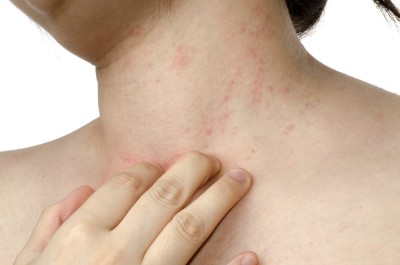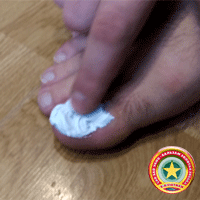Red dots on the body are not uncommon; most often they are either the result of an allergic reaction or hemangiomas, the so-called red moles. Let us consider in detail the reasons for the appearance of red dots on the skin, their types and various ways treatment.
1 Hemangiomas
Small red dots, or hemangiomas, are benign capillary tumors visible through the skin. The fact is that the tumor process weakens the walls of the capillaries and after a while, due to the accumulation of blood, protrusions develop on them, which appear on the skin as small red droplets. Hemangiomas have a number of identifying features that will help distinguish them from other types of red dots on the body.
The skin is responsible for our unique appearance and performs many functions. At the same time, the skin allows the loss of fluid, well dosed, to refresh the outside when necessary. In total, the skin consists of only three layers: epidermis, dermis and subcutaneous tissue. Each layer performs very different functions.
The top layer, the epidermis, protects us mainly from heat, cold and chemicals. It is covered with many bacteria that live on the surface of the epidermis. The epidermis is especially thick on the arms and legs, where its diameter can reach up to 2 mm. The average thickness of the epidermis is 0.05 mm.
- They look like regular moles, but are red in color.
- The spots have a clear outline without swelling or redness around.
- Their appearance on the skin usually does not cause any discomfort.
- Hemangiomas appear on the face, limbs, chest, abdomen, and less commonly on the human genitals.
The causes of hemangiomas are also varied and depend on various factors: age, health status, gender, genetic characteristics.
Epidermal cells multiply at such a rate that the complete epidermis is completely renewed only within a month. Every day the body loses 10 to 15 grams of dead cells. Below the epidermis is the dermis: it consists of a very dense network of collagen fibers, which gives the skin elasticity and deformability, as well as its resistance to tearing.
The dermis contains blood and lymphatic vessels, nerves, cells of the immune defense system, hair roots, multiple skin glands and pressure receptors. When it's cold, the small blood vessels in the dermis "tighten" as they warm up. It also affects skin color.
There are several most common reasons:
- Viruses, particularly herpes.
- Long-term exposure to chemicals - carcinogens - on blood vessels.
- Human age: many vascular diseases are caused by the aging of the body.
- For many women, red dots appear on the body due to hormonal imbalance.
- Hereditary predisposition. In this case, small red dots may appear in a newborn baby.
- Development of capillary tumors due to exposure to radiation.

The layer below the dermis, the hypodermis, consists primarily of fat and connective tissue. The lubricant serves as an energy reservoir and thermal insulator. Petechiae are small spots with a red to purple pattern most often appearing on the skin but can also occur on the surface certain organs or on the inner wall of some cavities, for example, Bladder. These spots are secondary to small hemorrhages.
Petechiae are also symptoms of various diseases such as certain infections or allergic reactions, but especially purpura is responsible for the formation of these lesions visible at the skin level by extravasation or the release of blood through the membrane of small vessels located just under the skin. They represent the smallest purple lesions.
- Removal surgically.
- Destruction of tumors using x-rays. This method is used to treat cavernous hemangiomas.
- Spot cauterization with carbon dioxide.
- Destruction by electric current - electrocoagulation.
- Sclerosis - introduction special substance into the tumor.
- Destruction of formation with liquid nitrogen - cryodestruction.
You can cure superficial hemangiomas at home; remedies will help with this traditional medicine: compresses of crushed dandelions and pineapple juice, rubbing with onion juice, lotions of garlic and lemon juice.
A characteristic feature of these petechiae and all purpuric lesions is that they do not disappear when pressure is applied to their contact. With daily manipulation of foods of all kinds, our immune defenses can suddenly become intolerable: they no longer maintain contact with any of these foods. When it comes into contact with it, the skin reacts after a few days. It becomes thick and inflammatory, it itches and is covered with small red spots. This is an allergic contact eczema that gradually peels off.
The easiest way to do this is to stop wearing or handling them. When hands touch, you can also put on gloves before using them to protect yourself. But identifying the culprit is sometimes less obvious: An allergenic shampoo can mainly cause neck skin that rinses to leak, and a dermatologist or allergist should do a little research.
You can self-medicate only after consultation with a specialist dermatologist, who will confirm that the red dots on the body are hemangiomas and not any other rashes. It is necessary to consult a specialist before using various juices so that it does not cause complications or allergic reactions.
Not to be confused with hypersensitivity
To do this, the doctor lists the products and circumstances in which the reaction occurred. He also finds out what may be allergic and what is not, as Jean-François Nicolas explains. Sometimes skin reactions are not allergic. These two concepts are often confused. When you suffer from allergic eczema, simply removing contact with the allergen is enough to make it go away. Skin must be protected against environmental hypersensitivity.
Run tests with fixes
The doctor again performs skin tests: he places a large adhesive rectangle on the skin, which carries samples of various suspected allergens: these function in the same way as many small spots that will remain in contact with the skin for 48 to 72 hours. The doctor then observes whether one or more foods caused a skin reaction. If the reaction is intense, an allergy may be considered, in which case it is recommended to avoid elimination and corticosteroid creams or ointments are prescribed to prevent possible manifestations. be it a form, since the longer it lasts, the more difficult it is to disappear.
2 Etiology of the disease
Red dots on the body may appear for other reasons. They often occur after inaccurate shaving in those places where microtraumas have occurred in the area of removed hairs. In winter and autumn, many people also sometimes experience red dots, this is caused by a lack of vitamin complexes in the body, such as group B, C and K.
What if your body is covered in acne?
Beware of the pimple eruption! Sometimes the whole body reacts. It is immediately covered with pimples, which scratch terribly and look like nettle stings: that is why it is called urticaria. The aspect is impressive, but without danger. It is associated with contact with latex, certain chemicals or cosmetics, and plants and animals. Some allergenic foods may even cause urticaria just by touch. But hives do not only appear after contact with the skin: it is also one of the forms that cause allergies after food or medicine.

Soft skin infant most susceptible to various kinds of irritations and. Many problems of this kind are caused by diapers in which groin area does not receive a child required quantity air and blows quickly. If your baby has red dots on his skin, discard diapers and replace them with cloth diapers.
Possible desensitization
In this case, hives are not the only symptom: nausea, vomiting or diarrhea also occur. This is potentially serious. Medical consultation and skin tests will allow you to assess the circumstances under which symptoms will appear and understand all these forms. In case of true allergies, oral medications are prescribed: antihistamine antiallergic or oral corticosteroids in case of severe manifestations. Contact with the allergen should be avoided as much as possible. “On the other hand, there are no desensitization protocols for skin allergens, but research is underway.”

Neoplasms such as angiomas arise as a result of benign pathology of blood vessels, most often capillaries. As a result, a small tubercle filled with blood forms on the surface of the skin. Sometimes there are spider-like angiomas, so named because a network of fine capillary lines diverges from the tubercle.
Medical consultation also identifies chronic urticaria, which, like eczema, is due to hypersensitivity: In this case, eviction cannot be ruled out. Hives can appear at any time or during life under the influence of any product, as soon as the amount is too large to "organize".
What are the symptoms of hives?
Symptoms Causes Diagnosis People at risk Prevention. . This can last from a few minutes to several hours. Acute urticaria, which is very common, is different from chronic urticaria, which is less common. Watch out for the pimple eruption! Red spots such as stinging, itchy nettles. . The plaques may cover the arms, legs, back, or other part of the body.
Angiomas can form on any part of the body. As already mentioned, they themselves are not at all dangerous and can only cause aesthetic discomfort if there are a lot of them or if they are on the face, for example. However, if the number of angiomas suddenly begins to increase sharply, you should consult a doctor, as this may be a sign of certain diseases, including malignant tumors. In the vast majority of cases, the cause of this phenomenon is problems with blood vessels (including natural age-related changes, which is why older people have a lot of red spots on the skin) or liver problems. Angiomas often appear in pregnant women.
What causes hives?
Hives are caused by the release of histamine, a chemical released into the body during an allergic reaction. Urticaria can be caused by: - consumption of histamine-releasing foods. - insect bites - some preservatives such as sulfites - some chemical substances contained in cosmetics, sunscreens. - certain medicines such as anti-inflammatory drugs or antibiotics. - latex - exposure to cold and heat.
Who is at risk?
See a doctor, therapist, or dermatologist. After examining and examining you, he may request blood tests or skin tests to screen for allergies. This is only necessary in cases of chronic or severe urticaria. People whose family members regularly suffer from hives.
Eat characteristic feature, by which angioma can be unmistakably distinguished from other skin tumors. If you press hard on such a red spot, it will a short time will become noticeably lighter, and then return to its normal color.
Do I need to get rid of angiomas?
If an angioma (or several angiomas) causes noticeable aesthetic discomfort, you can contact medical institution and remove it surgically. Currently, specialists can offer you non-surgical removal of skin tumors. Using a “vascular” laser, angiomas can be removed in 1-2 sessions. During this procedure, you will only feel a slight tingling and burning sensation. Typically, representatives of the fair sex resort to these measures in cases where angiomas are on the face. Removing angiomas at home is strictly unacceptable. At a minimum, an infection can be introduced into the body and an inflammatory process will begin. And in the worst case, such an “operation” can provoke the development of a malignant tumor.
It is necessary to clearly understand that the process of formation of angiomas is natural and irreversible, and with age the likelihood of their occurrence will increase. Therefore, it is better to simply ignore these bloody spots.
It is actually difficult to prevent a hives crisis. However, you can determine what is causing the attacks and be sure to eliminate the food or offending substance. Adoption antihistamines helps reduce itching. If antihistamines are not enough, your doctor may prescribe cortisone.
But there are other lesser-known allergens that can cause red spots or spots on the skin. This International Allergy Day, discover 5 allergies that are, thankfully, as rare as they are weird. In any case, cases of scabies are not uncommon today, so if your child scratches in the evening and has never had eczema, the most sensible thing to do is see a doctor. And if it really is scabies, then the whole family applies.
